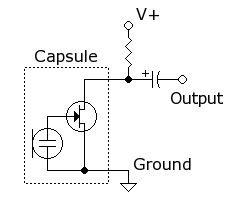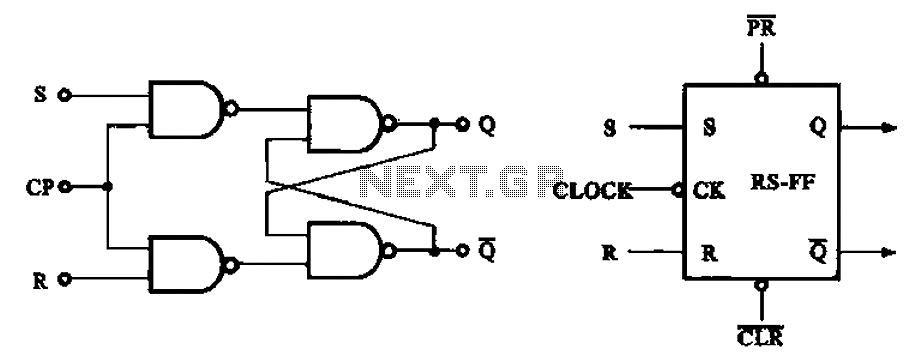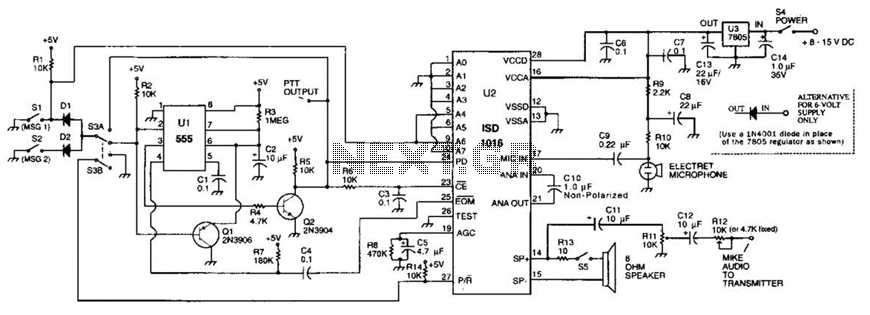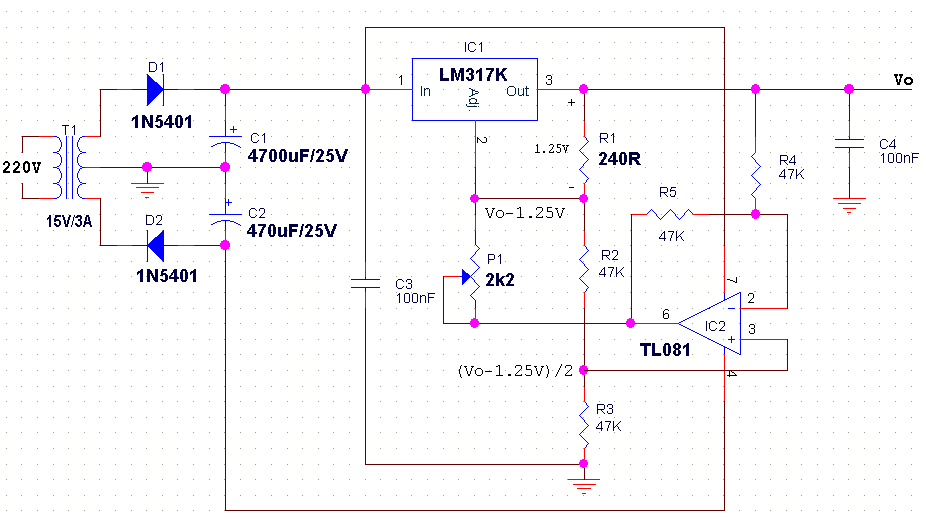
Solar Battery Charger Circuit
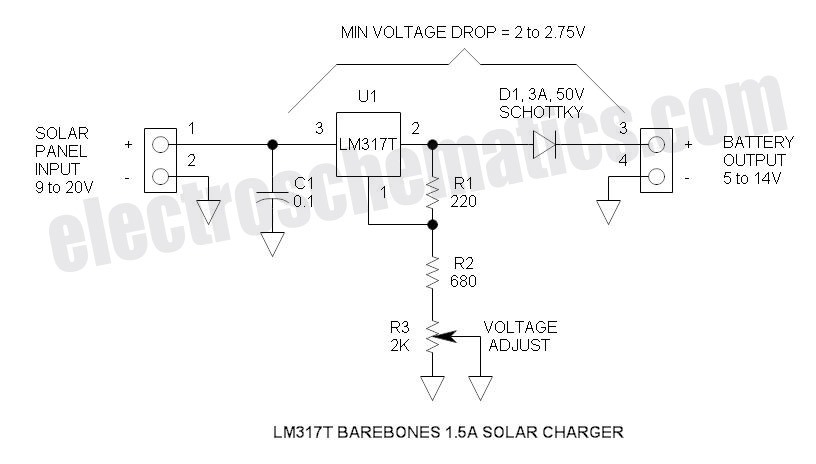
This solar battery charger is a simple and cost-effective project suitable for hobbyists. While it has some limitations compared to other similar devices, it offers several advantages. The charger is designed for lead-acid batteries but can also charge any battery at a constant voltage, with an adjustable output voltage. The input voltage must exceed the output voltage by approximately 2.75V at 1.5A. When the battery is discharged, the output voltage decreases, which lowers the solar panel voltage as well. When the battery is fully charged, the voltage is higher but the current is minimal; at this stage, the drop-out voltage reduces to about 2V, and the open-circuit solar panel voltage becomes relevant. A Schottky rectifier is used to minimize the head voltage requirement, as its voltage drop is about 0.5V at 1.5A, which is significantly less than that of a standard silicon rectifier. In this solar battery charger project, power is limited by the thermal resistances of both the LM317T voltage regulator and the heat sink. To maintain the junction temperature below the maximum of 125°C, the power must be limited to around 10W. If a smaller or less efficient heat sink is utilized, the maximum power dissipation must be reduced accordingly. The LM317 features internal temperature limiting, which protects it from damage by shutting down if it overheats. Maximum power is observed when charging a 12V battery at 1.5A; for example, with a battery voltage of 12V and a solar panel voltage of 18V, the power calculation is P = (18V - 12V) * 1.5A = 9W. This thermal design matches the current rating effectively. If a solar panel rated for 12V is used with a 6V battery, the maximum current should be limited to about 0.7A; for instance, with a battery voltage of 6V and a solar panel voltage of 18V, the power calculation is P = (18V - 6V) * 0.7A = 9.6W, thus the solar panel power must not exceed 10W. During charging, the heat sink typically remains warm, becomes hot when nearing maximum voltage, and cools down once the battery is fully charged. This heat is not wasted; rather, it represents excess power that is unnecessary for charging. Current limiting is inherently provided by the solar panel, which functions as a constant current device and can tolerate short circuits. This charger operates by maintaining a constant voltage to charge the battery and also supports float charging. The float charge voltage is slightly lower, necessitating a compromise by slightly reducing the voltage setting. To achieve optimal charging for a 12V battery, the control should be set to 14.6V. Automotive systems typically reduce the voltage to between 13V and 13.5V to accommodate high-temperature conditions, as batteries exhibit a negative thermal coefficient of voltage. To set the voltage correctly, it is advisable to fully charge the battery using an alternative method, then connect it to the charger with an ammeter in series. Adjust the voltage setting upwards until a significant current is observed, then decrease the potentiometer until the current drops to around 10mA. Certain battery types, such as lithium-ion, must be disconnected after charging to prevent degradation. There is no built-in protection against reverse polarity or miswiring. The system is safeguarded if the solar panel is connected in reverse without a battery or if the battery is connected in reverse without the solar panel. However, simultaneous misconnection of both the battery and solar panel could lead to uncertain outcomes.
This solar battery charger circuit typically consists of the following components: a solar panel, an LM317T voltage regulator, a Schottky rectifier, a heat sink, and various passive components such as resistors and capacitors for voltage adjustment and filtering. The solar panel generates DC voltage, which is fed into the LM317T. The LM317T regulates the output voltage to the desired level, ensuring it is suitable for charging the battery. The Schottky rectifier is employed to rectify the voltage with minimal loss, allowing for efficient power transfer. The heat sink is crucial for dissipating heat generated by the LM317T during operation, ensuring reliable performance and preventing thermal shutdown. The circuit may also include a potentiometer for fine-tuning the output voltage, enabling the user to adjust the charging voltage according to the specific requirements of the battery being charged. Overall, this design offers a practical solution for hobbyists interested in solar energy applications.This is the most simple and affordable solar battery charger that the hobbyist can make. It has a few drawbacks over other similar controls, but offers numerous advantages. It is intended for charging lead-acid batteries, but may also be used for charging any battery at a constant voltage. Voltage output is adjustable. This is also referred to dro p-out voltage. The input voltage must exceed the output voltage by about 2. 75V @ 1. 5A. Fortunately, when the battery discharged, the output voltage is lower so the solar panel voltage will also be lower. When fully charged, the battery voltage will be high, but the current is very low ”at this point, the drop-out voltage reduces to about 2V and the open circuit solar panel voltage also comes into play.
The schottky rectifier was selected to reduce this head voltage requirement ”the voltage drop of the schottky is about 0. 5V @ 1. 5A or about half that of a typical silicon rectifier. In this solar battery charger project the power is limited by the thermal resistances of both the LM317T and the heat sink.
To keep the junction temperature below the 125 °C Max, the power must be limited to about 10W. If a smaller or less effective heat sink is used, the maximum power dissipation must be de-rated. Fortunately, the LM317 has internal temperature limiting so that if it gets too hot, it shuts down thus protecting itself from damage. Max power comes into effect when charging a 12V battery @ 1. 5A: e. g. battery voltage = 12V, solar panel = 18V. P = (18V 12V) * 1. 5A = 9W. So thermally, it is carefully matched to the current rating. If a solar panel that is characterized for 12V is applied with a 6V battery, the maximum current must be reduced to about 0.
7A: e. g. battery voltage = 6V, solar panel voltage = 18V. P = (18V 6V) * 0. 7A = 9. 6W. In this case, the solar panel power may not exceed 10W. When charging, the heat sink normally runs warm. When beginning to top off or completing the charge at maximum voltage, the heat sink runs hot. When fully charged, the heat sink runs cool. This heat is not exactly wasted power ”it is excess power that is unneeded in the process of charging a battery. Current limiting is provided by the solar panel ”it is not a commonly understood fact that the solar panel tends to be a constant current device.
For this reason, a solar panel can withstand a short circuit. This control charges the battery at a constant voltage and also maintains a charged battery (float charge). The float charge voltage specification is a little lower, so to accommodate both charge and float charge voltage, a compromise is reached by simply reducing the voltage slightly ”that is how ALL automotive systems operate.
To obtain maximum charge in a 12V battery, set the control to 14. 6V. Automotive systems further reduce voltage to 13 to 13. 5V in order to accommodate high temperature operation as the battery is usually located in the hot engine compartment ”battery has a negative thermal coefficient of voltage. It is difficult to determine how to set the voltage in this case. The easiest way to do this is to charge the battery fully using other means and then transfer the charged battery to the control and connect an ammeter in series.
Increase the voltage setting until there is significant current and then back off the potentiometer until the current drops to perhaps 10mA or so. Some types of batteries such as lithium ion types must be disconnected after charging to prevent degradation.
There is no protection against reverse polarity or mis-wiring. It is protected if solar panel is connected reverse without battery connected, or if battery is connected reverse without solar panel connected. However, if the battery or solar panel is misconnected simultaneously, who knows anyone care to experiment
🔗 External reference
This solar battery charger circuit typically consists of the following components: a solar panel, an LM317T voltage regulator, a Schottky rectifier, a heat sink, and various passive components such as resistors and capacitors for voltage adjustment and filtering. The solar panel generates DC voltage, which is fed into the LM317T. The LM317T regulates the output voltage to the desired level, ensuring it is suitable for charging the battery. The Schottky rectifier is employed to rectify the voltage with minimal loss, allowing for efficient power transfer. The heat sink is crucial for dissipating heat generated by the LM317T during operation, ensuring reliable performance and preventing thermal shutdown. The circuit may also include a potentiometer for fine-tuning the output voltage, enabling the user to adjust the charging voltage according to the specific requirements of the battery being charged. Overall, this design offers a practical solution for hobbyists interested in solar energy applications.This is the most simple and affordable solar battery charger that the hobbyist can make. It has a few drawbacks over other similar controls, but offers numerous advantages. It is intended for charging lead-acid batteries, but may also be used for charging any battery at a constant voltage. Voltage output is adjustable. This is also referred to dro p-out voltage. The input voltage must exceed the output voltage by about 2. 75V @ 1. 5A. Fortunately, when the battery discharged, the output voltage is lower so the solar panel voltage will also be lower. When fully charged, the battery voltage will be high, but the current is very low ”at this point, the drop-out voltage reduces to about 2V and the open circuit solar panel voltage also comes into play.
The schottky rectifier was selected to reduce this head voltage requirement ”the voltage drop of the schottky is about 0. 5V @ 1. 5A or about half that of a typical silicon rectifier. In this solar battery charger project the power is limited by the thermal resistances of both the LM317T and the heat sink.
To keep the junction temperature below the 125 °C Max, the power must be limited to about 10W. If a smaller or less effective heat sink is used, the maximum power dissipation must be de-rated. Fortunately, the LM317 has internal temperature limiting so that if it gets too hot, it shuts down thus protecting itself from damage. Max power comes into effect when charging a 12V battery @ 1. 5A: e. g. battery voltage = 12V, solar panel = 18V. P = (18V 12V) * 1. 5A = 9W. So thermally, it is carefully matched to the current rating. If a solar panel that is characterized for 12V is applied with a 6V battery, the maximum current must be reduced to about 0.
7A: e. g. battery voltage = 6V, solar panel voltage = 18V. P = (18V 6V) * 0. 7A = 9. 6W. In this case, the solar panel power may not exceed 10W. When charging, the heat sink normally runs warm. When beginning to top off or completing the charge at maximum voltage, the heat sink runs hot. When fully charged, the heat sink runs cool. This heat is not exactly wasted power ”it is excess power that is unneeded in the process of charging a battery. Current limiting is provided by the solar panel ”it is not a commonly understood fact that the solar panel tends to be a constant current device.
For this reason, a solar panel can withstand a short circuit. This control charges the battery at a constant voltage and also maintains a charged battery (float charge). The float charge voltage specification is a little lower, so to accommodate both charge and float charge voltage, a compromise is reached by simply reducing the voltage slightly ”that is how ALL automotive systems operate.
To obtain maximum charge in a 12V battery, set the control to 14. 6V. Automotive systems further reduce voltage to 13 to 13. 5V in order to accommodate high temperature operation as the battery is usually located in the hot engine compartment ”battery has a negative thermal coefficient of voltage. It is difficult to determine how to set the voltage in this case. The easiest way to do this is to charge the battery fully using other means and then transfer the charged battery to the control and connect an ammeter in series.
Increase the voltage setting until there is significant current and then back off the potentiometer until the current drops to perhaps 10mA or so. Some types of batteries such as lithium ion types must be disconnected after charging to prevent degradation.
There is no protection against reverse polarity or mis-wiring. It is protected if solar panel is connected reverse without battery connected, or if battery is connected reverse without solar panel connected. However, if the battery or solar panel is misconnected simultaneously, who knows anyone care to experiment
🔗 External reference

